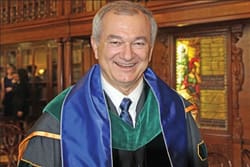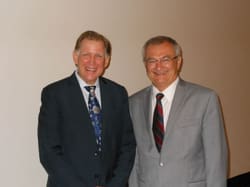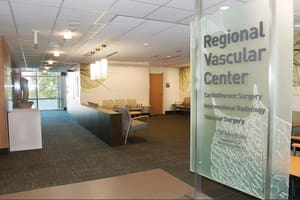 There is significant history behind the study and care of venous and lymphatic issues – Hippocrates certainly gave his two cents worth, as did Paré, Wiseman and Unna, just to mention a few. But in more modern times, two of our own American greats are making history as they continue their efforts to educate the next generation of surgeons on the latest advancements in the field. For the first time in the United States, the creation of a professorship in venous and lymphatic disorders has been established – with a unique emphasis on not one, but two exceptional honorees.
There is significant history behind the study and care of venous and lymphatic issues – Hippocrates certainly gave his two cents worth, as did Paré, Wiseman and Unna, just to mention a few. But in more modern times, two of our own American greats are making history as they continue their efforts to educate the next generation of surgeons on the latest advancements in the field. For the first time in the United States, the creation of a professorship in venous and lymphatic disorders has been established – with a unique emphasis on not one, but two exceptional honorees.
The Gloviczki Professorship: History in the Making
What’s in a name? Well, in this case, quite a lot, in fact. There’s no denying that the new Peter Gloviczki Professorship in Venous and Lymphatic Disorders is a mouthful, but whether you know, or simply know of, Dr. Gloviczki, you also know that it doesn’t even begin to do him justice. Dr. Gloviczki’s magic outside and inside the operating room is stuff of legend. And the fact that the recipient of this esteemed professorship is Dr. Mark Meissner is the cherry on top. But how did this all come about? The process, in this particular case, is rather unique.
“Universities, like the University of Washington, which have both clinical practices and research, regularly seek funds to establish professorships and chairs,” says Anne Aumell, MA, CFRE, who serves as Director for Philanthropy with UW Medicine Advancement.
“Professorships and chairs usually are named for the benefactor and held by a faculty member at an institution. Occasionally, a donor will fund a professorship or chair and wish to remain anonymous. However, this professorship is quite unusual,” she adds, “The donor is anonymous, and the professorship is named for a vascular surgeon who does not practice at UW Medicine. My colleagues and I have truly enjoyed upholding the donor’s wishes and celebrating this new professorship, which honors both Dr. Gloviczki’s significant and storied work here in the U.S. at the Mayo Clinic and Dr. Meissner’s contributions through his extensive work at UW Medicine.”
“It is not unusual for us to have anonymous donors. There are a couple of endowments here at the University that have endowed chairs, but there are no names attached to them. What is unusual in this case, and I think most interesting, is the fact that this professorship is named for a vascular surgeon who doesn’t have a position with the University of Washington,” notes Ms. Aumell. “Dr. Peter Gloviczki, as you know, is absolutely the leader in this field, but it is unusual for an organization or an institution to have a named professorship that is not named for the donor, but instead for a third party.”
“Anyone who has worked with Peter on writing projects knows that he is extremely patient with his co-authors, but keeps everyone on task and always makes the writing better with his editing skills.”
Indeed, the significance is an important point to ponder. While there is no specific link between Dr. Gloviczki and the University of Washington, the vascular, and in particular the venous and lymphatic communities, have been an ever-growing, close-knit group of professionals that collaborate often to help the burgeoning field overcome barriers, innovate and advance. As a result, it’s the history between these two outstanding surgeons that makes this particular connection complete.
“To me, what this really emphasizes is the longstanding professional and personal relationships,” Aumell goes on to say. “I think that Dr. Meissner, in his Grand Rounds,* underscored the connection that’s been made when he told the story of this branch of vascular surgery to the audience, and not only posited it within the world history of vascular surgery and our understanding of the lymphatic and venous systems, but really then gave it a sense of place here in the United States that I think is meaningful. That’s a part of the story that needs to be told, as well.”
The Gloviczki Professorship: A Magical Journey
In Communist Hungary, there once lived a young man with dreams of becoming a physician like his father. Early mentors promoted the idea of becoming a surgeon, and as a perfectionist, he set out to do just that. However, Dr. Gloviczki’s path is something special, having utilized his natural talents in slight-of-hand magic to gain access to the world, and more importantly, access to the medical community outside the Iron Curtain.
Utilizing the guise of magic competitions and performances, Gloviczki channeled his inner Houdini by appearing throughout Europe, all the while coordinating his magical travels with medical symposiums and events to increase his expertise in both general surgery and vascular surgery. He carved a path to Budapest where he was offered a position at a cardiovascular clinic and was mentored by Professor Lajos Soltesz.
Soon, he was awarded a fellowship in Paris, and it was there that Gloviczki was given the opportunity of a lifetime – a lab fellowship at the Mayo Clinic.
Before long, the two existing vascular fellowships at the Mayo Clinic grew to three, and this new position was offered to Gloviczki. After nine years of education in general surgery and vascular surgery, Dr. Gloviczki attempted board certification, but was denied because he had not trained in the United States. Determined, he then did additional training in general surgery in order to fulfill that certification.
He’s spent his entire career at the Mayo Clinic, ultimately serving as Chief of Vascular Surgery and as a standout within the community. A natural leader, Dr. Gloviczki reigns as “Most Likely to Have Served as President,” having been elected leader for more than a dozen significant vascular surgery organizations nationally and internationally.
Publishing more than 400 peer-reviewed manuscripts and more than 200 book chapters, Dr. Gloviczki has more than made his mark on the subjects of venous disease and lymphatic disorders. Dr. Meissner echoes what many have voiced, “Anyone who has worked with Peter on writing projects knows that he is extremely patient with his co-authors, but keeps everyone on task and always makes the writing better with his editing skills.”
Undoubtedly, it isn’t such a surprise that this honor has been bestowed upon Dr. Gloviczki.
 Meissner & Gloviczki: The Beginning of a Beautiful Friendship
Meissner & Gloviczki: The Beginning of a Beautiful Friendship
Interestingly, Dr. Meissner didn’t specifically set out to be a vascular surgeon. His studies in thoracic surgery at UW afforded him entre to the vascular fellowship and from that moment, there was no looking back. Meissner’s entire career has been at UW, beginning with general surgery residency and then the vascular fellowship, he began to shape his illustrious career by working as a protégé of Dr. Donald Eugene Strandness, revered as the innovator of the modern diagnostic method known as venous duplex ultrasound.
A founding father of the University of Washington School of Medicine and Medical Center, Dr. Strandness played an instrumental role in the utilization and acceptance of Doppler technology for the non-invasive visualization of venous hemodynamics.
It was through Dr. Strandness that Dr. Meissner was introduced to Dr. Gloviczki. “Dr. Strandness had great respect for Dr. Gloviczki as a young vascular surgeon and went out of his way to introduce him to me,” recollects Meissner.
“I believe it was in Ft. Lauderdale, in Florida, at the annual meeting of the American Venous Forum, in 1995,” recalls Dr. Gloviczki. “Dr. Meissner presented a paper on recurrence after acute deep vein thrombosis, one of the many studies on this subject he worked with his great mentor, Dr. Strandness.
He was enthusiastic, well prepared and just as always, he squeezed an inordinate amount of data into his 8-minute presentation.” It was during this meeting that Dr. Meissner was awarded the Servier Traveling Fellowship from the American Venous Forum.
“At that time,” adds Dr. Meissner, “Dr. Gloviczki was doing some of the early work on subfascial endoscopic perforator ligation. As part of the traveling fellowship, I spent several days with him at the Mayo Clinic, both in the operating room and in the clinic. This was a great experience as the Mayo Clinic has a long tradition of excellence in the management of venous disease. The world’s first vein service was developed at the Mayo Clinic, preceding the establishment of a formal vascular surgery service by almost seven decades. Peter has continued the Mayo Clinic’s tradition of excellence in the management of venous disease.”
Since then, the relationship between Dr. Meissner and Dr. Gloviczki has flourished. “In the last two decades we met every year at least once or twice, usually at the annual meetings of the SVS and AVF,” explains Dr. Gloviczki. “Since both of us served as presidents of the AVF, we had ample opportunities to work together there and in international committees, at meetings and at several Pacific Venous Symposia.” The two also met at the International Union of Phlebology meetings, a society where Dr. Meissner now is one of the vice presidents.
“When Dr. Strandness passed away in 2002, I invited Dr. Meissner to deliver the Strandness Lecture at the International Union of Angiology World Congress in New York. I think our relationship was special because we both were close to and admired his mentor, Dr. Strandness, tremendously,” shares Dr. Gloviczki.
“To express our gratitude, when I was president of the AVF, we renamed our annual guest lecture to Eugene Strandness Memorial lecture. Seattle and Rochester are quite apart, so it is hard to believe unless you search it on PubMed, that over the years, Dr. Meissner and I co-authored 12 peer reviewed publications on venous disease.” In addition, the two have worked together on various chapters in Rutherford’s Vascular Surgery and in the Handbook of Venous and Lymphatic Disorders.
“We have worked together on several American Venous Forum projects, the most important of which have been the AVF guidelines for the management of chronic venous disease and those for early thrombus removal,” says Meissner. “These are widely recognized as establishing the standards for the management of venous disease throughout the world.”
Not one to relish the limelight, Dr. Meissner is quick to point out the contributions of his mentors throughout his journey. “The two most important people in my own career have been Dr. Gloviczki and Dr. Gene Strandness. As academic leaders, both were enthusiastic about promoting the ideas of young surgeons and they were both very supportive of me in starting my career.”
“Dr. Meissner has served as visiting professor at Mayo Clinic and most recently, I had the privilege to be visiting professor at the University of Washington,” adds Dr. Gloviczki. “During the years we also trained excellent residents and fellows who came to us from the University of Washington.”
 Deserving Recognition
Deserving Recognition
Not one to relish the limelight, Dr. Meissner is quick to point out the contributions of his mentors throughout his journey.
“The two most important people in my own career have been Dr. Gloviczki and Dr. Gene Strandness. As academic leaders, both were enthusiastic about promoting the ideas of young surgeons and they were both very supportive of me in starting my career. They both encouraged my ideas and gave me the opportunity to present them to the vascular community. Their commitment to mentoring and promoting the next generation of clinicians is a model for those in academic surgery.”
Dr. Gloviczki also sings high praise for the recipient. “There are strict criteria at every institution to receive a named professorship and as one of the premier academic institutions in this country, the University of Washington in Seattle is no exception. Dr. Meissner met, and in many areas, exceeded the requirement needed to receive a named professorship. He excels in clinical practice, education and research.
He is an international authority on evaluation and treatment of venous and lymphatic diseases, particularly in areas of venous duplex scanning, acute deep vein thrombosis, and pelvic congestion syndrome, treatment of chronic venous disease and outcome assessments.”
When asked about the significance of this honor, Meissener emphasizes, “This professorship means a lot to me as well as to the Mayo Clinic, the University of Washington, and the venous community at large. As you know, this is the first professorship of its kind in the United States (there is one professorship of venous surgery in Europe, given to Dr. Cees Wittens). Specifically here in the U.S., the development of this professorship illustrates the evolution of venous disease over the past several decades to the point where it truly is a specialty in its own right.
I do believe that the recognition of venous specialists in academic medicine will further the recognition of and development of the specialty. From the Mayo Clinic’s and University of Washington’s standpoint, the professorship clearly recognizes the vital contributions both institutions have made to the field of venous disease – the development of venous surgery as a specialty at the Mayo Clinic and the development of duplex ultrasound at the University of Washington. I truly believe that both of these institutions have made the very most important contributions to venous disease over the last century, and it is very fitting that both be recognized with this professorship.”
"With this program, I am hopeful that Dr. Meissner will be able to start a fellowship in venous and lymphatic disorders that assures first class training for those who select this area for their special expertise,” adds Dr. Gloviczki.
As the first of its kind, Dr. Meissner believes the professorship will help foster new inroads within education in venous disease. “As far as the opportunities that the professorship affords, there is clearly the recognition that having a dedicated professorship of venous and lymphatic disorders brings to the entire field of venous disease,” says Meissner.
“However, it also provides an opportunity for me personally to advance some aspects of the field which are still in their infancy, specifically abdominal and pelvic venous disease. Although the technology for managing abdominal and pelvic venous disease is rapidly advancing, there remains much to be done with respect to our understanding of the underlying pathophysiology and the development of classification and outcome instruments. I hope to use some of the funding provided by the professorship to further investigate these areas.”
 Dr. Gloviczki also sees great promise with the advent of this position. “Venous disease used to be the stepchild in medicine. Today, thanks to spectacular progress in the field on endovascular and endovenous therapies, venous disease management has become popular, minimally invasive and effective.
Dr. Gloviczki also sees great promise with the advent of this position. “Venous disease used to be the stepchild in medicine. Today, thanks to spectacular progress in the field on endovascular and endovenous therapies, venous disease management has become popular, minimally invasive and effective.
Venous specialists, however, need to have adequate training and they must use appropriate indications to perform these procedures based on evidence based guidelines. This professorship accomplishes two objectives in our quest to deliver the best care to our patients.
First, it recognizes venous and lymphatic disorders as a defined field for vascular specialists. Second, it will provide a program with training of venous and lymphatic disease experts. This is a major step forward since this is the first professorship in venous and lymphatic disorders in North America. For the sake of this subspecialty and for the benefit of patients with venous diseases and chronic lymphedema, I am hopeful that other, similar professorships will be established.
“With this program, I am hopeful that Dr. Meissner will be able to start a fellowship in venous and lymphatic disorders that assures first class training for those who select this area for their special expertise,” adds Dr. Gloviczki. “Such a program can also help venous and lymphatic education of residents and fellows who are already enrolled in an accredited vascular residency or fellowship program. A named professorship at such a prestigious institution is a tremendous privilege and Dr. Meissner is fully qualified to receive such recognition from his peers.
I congratulate him for this well-deserved honor. I am extremely thankful for the endowment by an anonymous benefactor, who had the vision and generosity to sponsor such a professorship and at the same time recognize both of us and our institutions, the University of Washington in Seattle and Mayo Clinic in Rochester, Minnesota.”
Dr. Meissner acknowledges Gene Strandness and Peter Gloviczki for encouraging his interest in venous disease and giving him the many academic opportunities to develop these interests over the past two decades. “I would also thank Bob Rutherford for giving me similar opportunities and stimulating an interest in outcome measures.
Most importantly, I would thank the anonymous donor of this position, both for recognizing the importance of venous disease and the contributions that this professorship will make towards advancing the field, as well as for recognizing Dr. Gloviczki, myself, the Mayo Clinic, and the University of Washington.”


